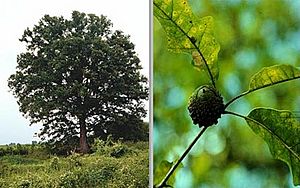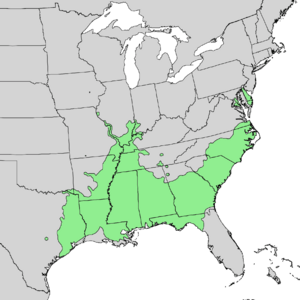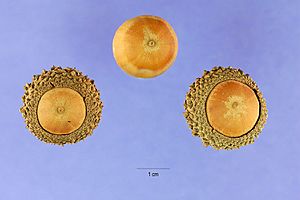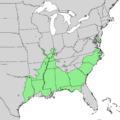Overcup oak facts for kids
Quick facts for kids Overcup oak |
|
|---|---|
 |
|
| Conservation status | |
| Scientific classification | |
| Genus: |
Quercus
|
| Species: |
lyrata
|
 |
|
| Synonyms | |
|
|
The Overcup Oak (scientific name: Quercus lyrata) is a special kind of oak tree. It belongs to the white oak group. Its common name, "overcup oak," comes from its acorns. These acorns are almost completely covered by their cup, like a little hat!
This tree grows naturally in wet, low-lying areas across the eastern and south-central United States. You can find it from New Jersey all the way to Texas, and inland to states like Oklahoma, Missouri, and Illinois. It used to grow in Iowa, but it's not found there anymore. The Overcup Oak grows slowly, taking about 25 to 30 years to become fully grown. It can live for a very long time, sometimes up to 400 years!
Contents
Discover the Overcup Oak's Features
The Overcup Oak is a medium-sized deciduous tree. This means it loses its leaves every fall. It can grow as tall as 80 feet (24 meters), but some have been found to be much taller, up to 154 feet (47 meters)! Its trunk can be about 31 inches (80 cm) wide, and sometimes even wider.
Leaves and Bark
The leaves of the Overcup Oak are simple and grow one after another on the branch. They are usually 6 to 8 inches long. They are wide, with deep lobes, and look a bit like a lyre (a type of harp). The leaves feel leathery. The top side is dark green and shiny, while the underside is a lighter gray-green with tiny hairs. In the fall, the leaves turn pretty shades of red, yellow, and brown. Like other oak trees, the Overcup Oak has buds grouped together at the end of its branches.
The bark of the Overcup Oak is light to dark gray. It has deep ridges and furrows, making it look rough and textured.
Flowers and Acorns: Life Cycle
The Overcup Oak has both male and female flowers on the same tree. This is called being monecious. The male flowers are often brown or yellow and hang down in long clusters. The female flowers look like small reddish spikes surrounded by leaves.
The fruit of the Overcup Oak is its acorn. These acorns are usually oval or oblong, about 1/2 to 1 inch long. As its name suggests, the acorn is almost completely covered by its cup. The cup has gray, fuzzy scales. A cool thing about these acorns is their unique spongy shell, which makes them float in water! This helps them travel to new places. The outer part of the acorn (called the pericarp) is much larger in Overcup Oak acorns than in other oak trees.
The male and female flowers appear in mid-spring, around April or May. After the flowers, the acorns take about 6–7 months to grow. They are usually ready between 1 and 2 inches long. Because they float, acorns are often spread by water, especially in the wet places where these trees like to grow. Acorns grow best in moist soil that is covered with fallen leaves.
Where the Overcup Oak Lives
The Overcup Oak grows across a large area in the central and eastern United States. You can find it in all the coastal states from New Jersey to Texas. It also grows inland in states like Oklahoma, Missouri, and Illinois. Smaller groups of these trees are found in Delaware, Tennessee, Maryland, and Alabama. Sadly, it is considered endangered in New Jersey.
This tree loves to live in wet areas like floodplains, wetlands, and swamps. It prefers clay soils that are often poorly drained and get a lot of flooding. The Overcup Oak is tough! It can survive being continuously flooded for two or more growing seasons. It often grows alongside other trees like Willow Oak, American Elm, Green Ash, Water Hickory, and Red Maple.
Uses of the Overcup Oak
For People
The wood of the Overcup Oak is not as valuable as other white oaks. This is because it can get damaged or sick more easily. However, its wood can still be used for lumber and for making barrels (called cooperage). It's not usually used for fancy furniture. People can also use it as firewood, and its acorns can even be eaten by humans! Sometimes, the tree is planted just for its beauty in gardens or parks.
For Wildlife
The Overcup Oak is very important for many animals. Its acorns are a food source for small mammals and birds, like squirrels and wild turkeys. While deer usually don't eat it much, white-tailed deer do enjoy its acorns. The tree also provides shade and a home for many different species.
Like many oak trees, the Overcup Oak is a habitat for various Lepidoptera (moths and butterflies). These include the Imperial Moth, Banded Hairstreak, Edward's Hairstreak, Gray Hairstreak, White M Hairstreak, Horace’s Duskywing, and Juvenal’s Duskywing.
Protecting the Overcup Oak
The IUCN Red List (International Union for Conservation of Nature) says the Overcup Oak is of "least concern." This means it's not currently at high risk of disappearing. However, the United States Department of Agriculture (USDA) says it is endangered in New Jersey. It's hard to know exactly how many Overcup Oaks there are because they grow over such a huge area.
Future Challenges
Climate Change
Scientists expect that climate change will affect the Overcup Oak. By 2050, it might lose over 40% of the places where it can grow. This could mean the IUCN might change its status to "near-threatened" or even "threatened." However, different studies have different ideas about how climate change will impact this tree.
Pests and Diseases
The Overcup Oak can be affected by certain insects, such as the oak skeletonizer, oak lace bug, nut weevil, and leaf miners.
Like many other oaks, the Overcup Oak can get several plant diseases. These include chestnut blight, armillaria root rot, oak leaf blister, and powdery mildew. However, it is strong against oak wilt, a serious disease for many other oak trees.
Images for kids
See also
 In Spanish: Quercus lyrata para niños
In Spanish: Quercus lyrata para niños






